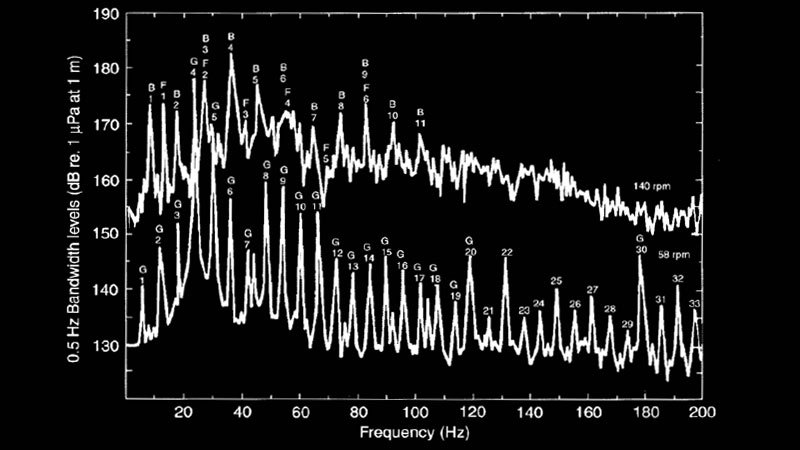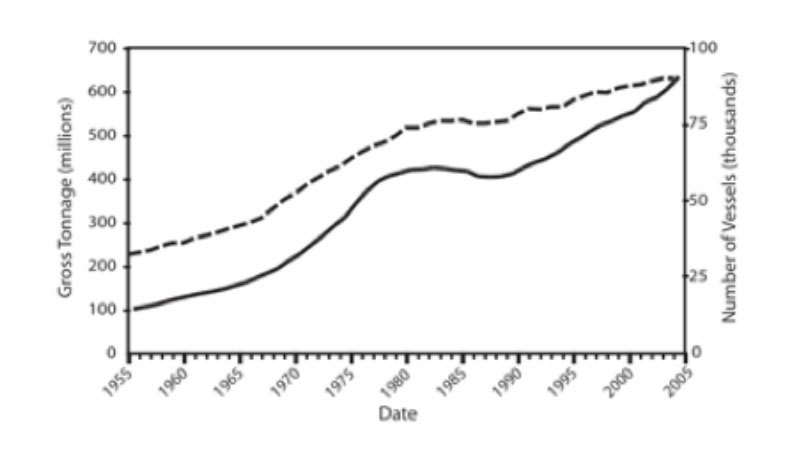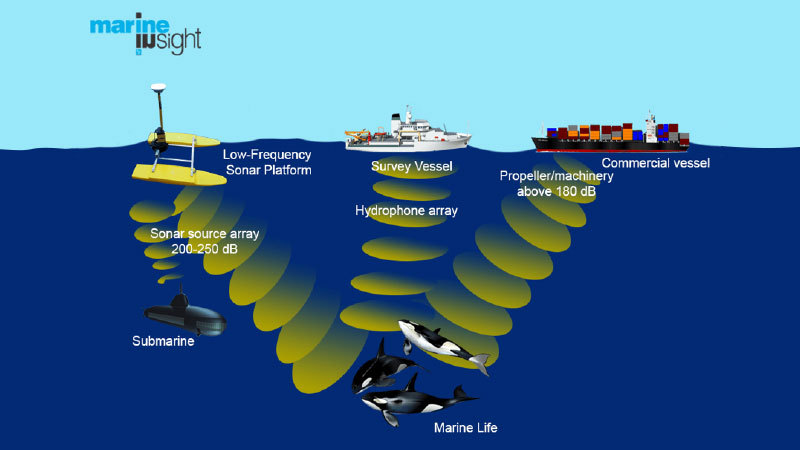Effects of the Shipping Industry of Sound in the Sea
The shipping industry has been interested in Sound propagation primarily due to concerns of crew performance and safety. A noisy ship can have affects on crew tiredness etc. and therefore the IMO have introduced the Noise Code on board commercial ships (Resolution A.468[XII] IMO 1981). This code applies to all ships over 1600 G.T. there are a number of exceptions (pipe laying, offshore drilling units etc.). Overall this Code is designed to prevent hazardous noise. There are also regulations for passenger ships and are defined for Decibel (sound power) for specific passenger spaces.
However what is starting to gain attention is the role of the commercial shipping industry on increased noise in the sea, which is dependent on hull design and propulsion systems. Ships produces noise at 50 to 200 Hz while other sound sources such as breaking waves are at 500-100,000 Hz. Marine mammals communicate at the lower frequency so hence interest in ship noise. Obviously the regions of the world with more shipping the greater the noise, and most of the shipping routes are in the Northern hemisphere so that is where the greatest concern is geographically.

Figure 1 provides a view of low frequency noise from a ship due to propeller blade rate to provide a view of generator, blade and engine firing at 2 different speeds. Unfortunately nothing is simple as low frequency noise appears to be affect baleen whales but high frequency noise of say 20,000 Hz may affect killer whales find prey. The findings, suggest that the noise could well affect the endangered population of killer whales that are found near shipping lanes. It was noted that a population of just 84 killer whales forage up the US west coast and into Puget Sound.
“The main concern of this is that even a slight increase in sound may make echolocation more difficult for whales,” said Scott Veirs of Beamreach, who led the research. “That’s worrying because their prey, chinook salmon, is already quite scarce. Hearing a click off a salmon is probably one of the most challenging things a killer whale does. Hearing that subtle click is harder if there’s a lot of noise around you.”
The researchers used underwater microphones to measure the noise created by about 1,600 individual ships as they passed through Haro Strait, in Washington State. The two-year study captured the sound made by 12 different types of vessel, including cruise ships, container ships and military vessels, which passed through the strait about 20 times a day.
Some ships are quieter than others but the average intensity of noise next to all the ships was 173 decibels, equivalent to 111 decibels through the air – about the sound of a loud rock concert. Whales are not usually located right next to ships and so would be subjected to noise of about 60 to 90 decibels – around the level of a lawnmower or a vacuum cleaner.
Prior to the Industrial revolution most of the noise was high frequency from bursting bubbles and waves however once powered vessels were used to transport goods the low frequency noise increased. Figure 2 shows the number of vessels as a dashed line and gross tonnage (solid line) increase from 1955 to 2005.

Of course this is not necessarily an indication of increased in low ambient noise as number of ships and GT don’t correlate as ship design and propulsion changed significantly over time. Navy hydrophones have suggested that in the Pacific between 1950 -1950, low frequency (50Hz) noise was increasing by 0.55 dB/year. However various studies have shown that in 1980 the rate changed off the west coast of California to about 0.2 dB/year.

The cartoon above provides an overview the type of ship noise. There are claims that the effects of underwater noise pollution is more painful than anything else for the animals. Most animals are alarmed by these alien sounds. The deaths can occur due to haemorrhages, changed diving pattern, migration to newer places, and damage to internal organs and an overall panic response to the foreign sounds. There is also a disruption in normal communication between marine animals as a result of underwater noise pollution. This means animals prone to noise pollution are unable to call their mates, look for food or even make a cry for help under such circumstances.
The problem is that the research on marine noise is still in its infancy but the best opportunity is the shipping industry to engage with the Environmental world on this. The International Maritime Organization (IMO) recently adopted guidelines to reduce underwater noise from commercial ships. The new guidelines recognize that shipping noise can have short-term and long-term impacts on marine life; call for measurement of shipping noise according to objective ISO standards, which are themselves on the verge of adoption; identify computational models for determining effective quieting measures; provide guidance for designing quieter ships and for reducing noise from existing ships, especially from propeller cavitation; and advise owners and operators on how to minimize noise through ship operations and maintenance, such as by polishing ship propellers to remove fouling and surface roughness.
There is a concept that the ocean is the “silent word” however it is not. It is good that the shipping industry through \ IMO are trying to do something about shipping noise in the ocean and my advice would be for the industry to get involved with the scientific community. One group of very responsible scientists are the International Quiet Ocean Experiment. This website is an excellent place to get realistic views on the effect of ocean noise on the organisms who live in it.